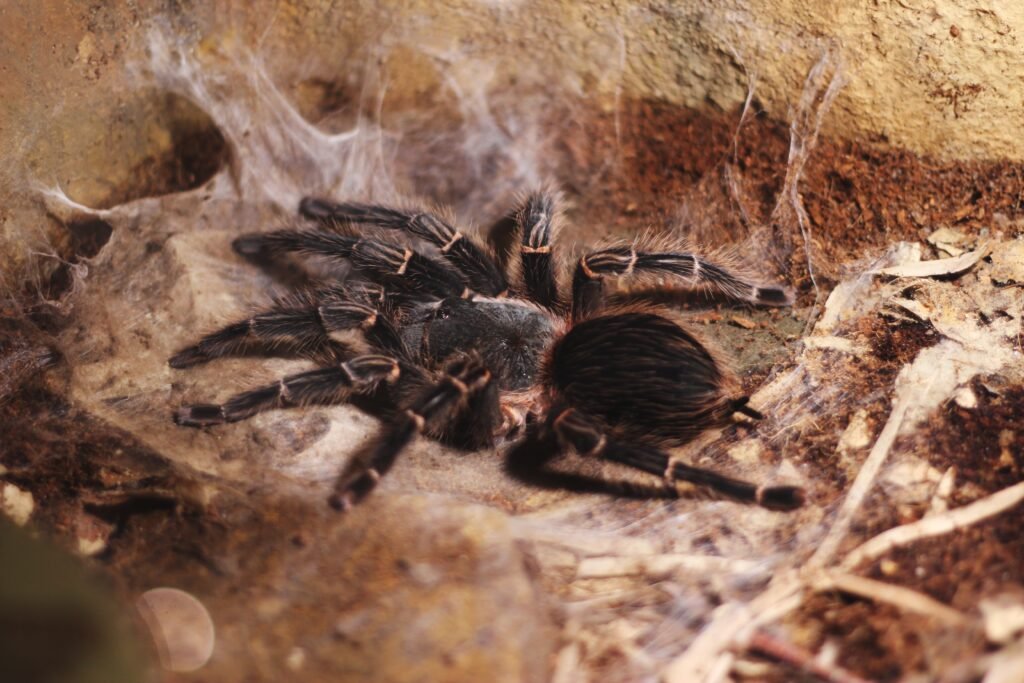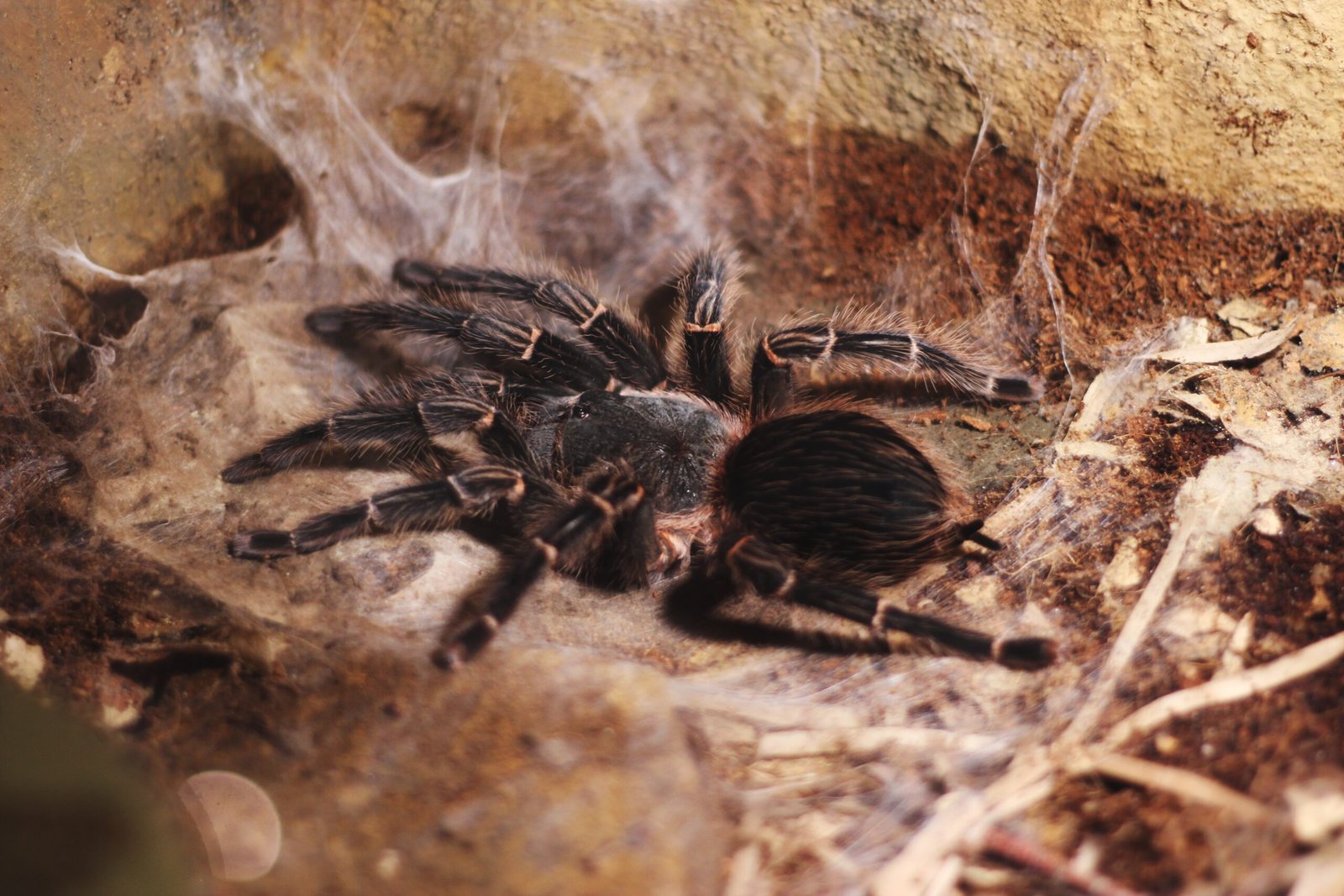Are you a proud tarantula owner, wondering about the best feeding schedule and prey size for your eight-legged friend? Look no further, as this article will provide you with all the information you need. Understanding the correct frequency of feedings and the appropriate prey size is crucial for the well-being and growth of your tarantula. So, let’s explore the fascinating world of tarantula feeding together!

Feeding Frequency
Frequency for Adult Tarantulas
For adult tarantulas, the feeding frequency can vary depending on the species and individual metabolism. On average, adult tarantulas should be fed once every week or every two weeks. However, some species may require more frequent feedings, while others may require less. It is important to observe your tarantula’s behavior and body condition to determine the appropriate feeding frequency. Overfeeding can lead to obesity and health issues, so it is always better to err on the side of caution and feed less frequently if in doubt.
Frequency for Juvenile Tarantulas
Juvenile tarantulas, which are typically between 1 and 2 years old, have a faster metabolism and higher energy needs compared to adults. They should be fed more often to support their growth and development. Generally, juvenile tarantulas should be fed two to three times a week. Keep in mind that the exact frequency may vary depending on the species and individual tarantula.
Frequency for Spiderlings
Spiderlings, which are newly hatched tarantulas, have particularly high energy requirements due to their rapid growth rate. They need to eat frequently to sustain their growth and ensure proper development. Spiderlings should be fed every one to two days, providing them with small prey items appropriate for their size.
Prey Size
Appropriate Prey Size for Adult Tarantulas
When it comes to prey size for adult tarantulas, it is important to provide appropriately-sized prey items to ensure successful feeding and prevent choking hazards. In general, the prey should be roughly the same size as the tarantula’s cephalothorax (the body part where the legs are attached). The prey should also not be too large or too small for the tarantula to handle comfortably. It is better to slightly underestimate the prey size rather than risk overfeeding and potential health issues.
Appropriate Prey Size for Juvenile Tarantulas
Juvenile tarantulas have smaller bodies compared to adults, and thus, they require smaller prey items. Ideally, the prey size should be around three-quarters of the tarantula’s cephalothorax. It is important to provide prey that is not too large, as it can pose a choking hazard, but also not too small, as it may not provide sufficient nutrition for the growing tarantula.
Appropriate Prey Size for Spiderlings
Spiderlings are tiny and delicate creatures, so it is crucial to provide prey items that are proportionate to their size. Prey for spiderlings should be small enough for them to capture and consume easily. Suitable prey items include fruit flies, pinhead crickets, and small insects. As spiderlings grow, the prey size can gradually increase to accommodate their development.
Factors Influencing Feeding
Tarantula Species
Different tarantula species have varying feeding requirements. Some species are known to have faster metabolisms and higher energy needs, while others may have slower metabolisms and require less frequent feedings. It is essential to research the specific needs of the tarantula species you own to determine the appropriate feeding frequency and prey size.
Tarantula Size
The size of a tarantula can greatly influence its feeding frequency. Smaller tarantulas typically have faster metabolisms and higher energy needs compared to larger tarantulas. As tarantulas grow and mature, their feeding frequency may decrease. It is important to monitor the tarantula’s body condition and adjust the feeding schedule accordingly to prevent overfeeding or underfeeding.
Metabolic Rate
Each tarantula has its own unique metabolic rate, which can be influenced by factors such as temperature, humidity, and overall health. Tarantulas with faster metabolisms require more frequent feedings to meet their energy needs. Conversely, tarantulas with slower metabolisms may require less frequent feedings. Monitoring the tarantula’s behavior, appetite, and body condition can help determine the appropriate feeding schedule based on its metabolic rate.
Breeding and Mating Season
During breeding and mating seasons, tarantulas may alter their feeding habits. Males, in particular, may exhibit a reduced appetite as they focus on finding a mate. Females may also decrease their feeding frequency as they prepare for egg-laying. It is crucial to be aware of these seasonal changes and adjust the feeding schedule accordingly to avoid unnecessary stress or health issues.
Other Health Factors
There are various health factors that can impact a tarantula’s feeding habits. Illnesses, infections, or injuries may cause a loss of appetite or difficulties in capturing prey. It is important to monitor your tarantula’s behavior, appearance, and feeding response regularly. If you notice any abnormalities or concerns, it is advisable to seek veterinary advice to ensure your tarantula receives appropriate care and treatment.
Feeding Habits of Tarantulas
Opportunistic Feeders
Tarantulas are generally opportunistic feeders, meaning they will eat whenever prey is available. In the wild, they may go for extended periods without food, relying on a sporadic food source. However, in captivity, it is essential to provide regular and appropriate meals to ensure their nutritional needs are met. By observing their feeding habits, you can determine their preferences and adjust the feeding strategies accordingly.
Ambush Predators
Some tarantulas are ambush predators, patiently waiting for their prey to come within striking range. These tarantulas will typically remain motionless until an opportunity arises, relying on camouflage to remain undetected. Once the prey is in range, they will swiftly capture and immobilize it before consuming it. It is important to mimic their natural feeding behavior by providing appropriate prey items and creating a suitable feeding environment.
Abdominal Constriction
Tarantulas have a unique feeding method known as abdominal constriction. After capturing their prey, they wrap their legs around it and use their fangs to inject venom. The venom serves to immobilize and begin the digestion process. The tarantula then uses its pedipalps and chelicerae to manipulate the prey and release digestive enzymes to break it down further. This feeding process highlights the importance of providing prey items appropriate for the tarantula’s size and capabilities.
Venom and Digestive System
Tarantulas possess venom that serves multiple purposes, including subduing prey and aiding in digestion. The venom contains enzymes that help break down the prey’s tissues, making it easier for the tarantula to extract nutrients. The potency of venom can vary among different tarantula species. It is crucial to understand the venomous capabilities of your tarantula and handle it with caution, especially during feeding.

Feeding Methods and Techniques
Live Feeding
Live feeding involves providing live prey for the tarantula to hunt and capture. This method mimics the natural feeding behavior of tarantulas and can stimulate their hunting instincts. However, live feeding comes with risks, as the prey may injure the tarantula or carry parasites or diseases. It is crucial to supervise live feedings and ensure the prey is appropriate in size and health.
Pre-killed or Frozen-Thawed Feeding
Pre-killed or frozen-thawed feeding involves providing prey that has been killed beforehand or frozen and thawed out. This method eliminates the risks associated with live feeding and allows for better control over the prey size. Pre-killed or frozen-thawed prey should be presented to the tarantula in a way that simulates live prey, such as by gently wiggling it with tongs.
Tong Feeding
Tong feeding is a method where prey is presented to the tarantula using long forceps or feeding tongs. This technique allows for precise control when offering prey items and minimizes the risk of the tarantula accidentally being bitten or injured during the feeding process. It is particularly useful for tarantulas that are more skittish or less accustomed to handling.
Forceps Feeding
Forceps feeding is similar to tong feeding, but instead of using tongs, forceps are used to hold and present the prey to the tarantula. This method requires a delicate touch and precise control to ensure the tarantula can easily capture and consume the prey without injury.
Feeding Frenzy Prevention
Feeding frenzies can occur when multiple tarantulas are housed together or when offered large amounts of prey at once. Feeding frenzies can lead to competition, aggression, and potential injuries among tarantulas. To prevent feeding frenzies, it is advisable to feed tarantulas individually and provide enough space for each tarantula to feed without interference.
Balancing Frequency and Obesity
Risk of Overfeeding
Overfeeding can have detrimental effects on a tarantula’s health and well-being. Excessive food intake can lead to obesity, which puts strain on the tarantula’s exoskeleton and internal organs. It can also increase the risk of developing metabolic disorders and shorten the tarantula’s lifespan. As a responsible tarantula owner, it is important to be cautious and avoid overfeeding.
Obesity and its Consequences
Obesity in tarantulas can cause a variety of health problems. The excess weight can make movement and molting difficult, leading to mobility issues and potential injuries. Obese tarantulas may also experience respiratory problems and have a higher susceptibility to infections and diseases. To prevent obesity, it is crucial to provide a balanced and appropriate diet, monitor the tarantula’s body condition, and adjust the feeding frequency accordingly.
Determining the Ideal Frequency
Finding the ideal feeding frequency for your tarantula requires careful observation and consideration of various factors, including species, size, metabolic rate, and overall health. Ideally, the tarantula should maintain a healthy body condition without excess weight or visible ribs. If the tarantula appears too thin, it may be necessary to increase the feeding frequency and prey size. Conversely, if the tarantula is overweight, reducing the feeding frequency may be necessary.
Monitoring Weight and Body Condition
Regularly monitoring your tarantula’s weight and body condition is crucial to ensure its well-being. You can do this by gently weighing your tarantula using a digital scale designed for small animals. Additionally, visually inspecting the tarantula’s body can provide insight into its overall condition. A healthy tarantula should have a plump abdomen but not to the point of being distended. Adjust the feeding frequency and prey size accordingly to maintain a healthy body condition.

Feeding Strategies for Different Tarantula Species
Terrestrial Species
Terrestrial tarantulas, which primarily dwell on the ground, often exhibit a more active feeding response. They tend to rely on stalking and ambushing their prey. Providing appropriately-sized prey items and offering them near their hiding spots can enhance their natural feeding behavior. It is important to note that some terrestrial species may require larger prey, while others may prefer smaller prey.
Arboreal Species
Arboreal tarantulas, which reside in trees and plants, have unique feeding behaviors. They tend to be more patient and may wait for prey to pass by rather than actively hunting. It is advisable to offer small prey items appropriate for their body size and place the prey near their web or resting spots to encourage feeding.
Burrowing Species
Burrowing tarantulas create intricate tunnels or burrows in the ground, which they use as their home and feeding site. Feeding burrowing tarantulas can be challenging, as they spend most of their time hidden within their burrows. In such cases, it is recommended to drop or place prey items directly in or near the burrow entrance. The tarantula will detect the prey and emerge to capture it.
Fast-Growing Species
Fast-growing tarantula species have high metabolic rates and rapid growth rates. They require more frequent feedings and larger prey items to sustain their growth. It is essential to closely monitor their body condition and adjust the feeding schedule accordingly to prevent underfeeding or overfeeding.
Slow-Growing Species
Slow-growing tarantula species have lower metabolic rates and slower growth rates. They typically require less frequent feedings and smaller prey items compared to fast-growing species. Although slow-growing tarantulas may not consume prey as often, it is important to ensure that the prey is of appropriate size to meet their nutritional needs.
Advice for New Tarantula Owners
Researching the Tarantula Species
Before acquiring a tarantula, it is crucial to research the specific species’ feeding habits, care requirements, and potential challenges. Understanding the tarantula’s natural habitat, behavior, and dietary preferences will help you provide appropriate care and feeding strategies.
Consulting Expert Opinions
Consulting with experienced tarantula keepers, breeders, or experts can provide valuable insights and advice on feeding techniques, prey selection, and caring for your tarantula. Online forums, social media groups, and local tarantula clubs are excellent resources for connecting with knowledgeable individuals who can share their experiences and expertise.
Monitor & Observe Behavior
Regularly monitoring and observing your tarantula’s behavior and appetite is essential for detecting any changes or health issues. Look for signs of abnormal behavior, loss of appetite, or excessive weight gain. By being attentive to your tarantula’s needs, you can adjust the feeding frequency and prey size accordingly to ensure its well-being.
Record Keeping
Maintaining a feeding log or journal can be beneficial in tracking your tarantula’s feeding habits, weight changes, and overall health. Note the dates of feedings, prey size, and any observations or concerns. This will help you establish a consistent feeding routine and provide valuable information for future reference or when seeking veterinary advice.
Seeking Veterinary Advice
If you notice any significant changes in your tarantula’s feeding habits, weight, or overall health, it is advisable to seek veterinary advice. Tarantula-specific veterinarians can provide expert guidance and diagnosis if your tarantula appears unwell or experiences prolonged loss of appetite. Early intervention can often prevent or address potential health issues.

Potential Feeding Challenges
Loss of Appetite
Tarantulas may occasionally experience a loss of appetite, which can be caused by factors such as stress, illness, molting, or environmental changes. If your tarantula refuses to eat for an extended period or exhibits other concerning symptoms, it is best to closely monitor its behavior and consult a tarantula veterinarian if necessary.
Molting Period
During the molting process, tarantulas shed their old exoskeleton to grow and develop. Before and during molting, tarantulas often lose their appetite and become more inactive. It is essential to refrain from feeding during this time, as the tarantula’s exoskeleton becomes rigid, making it difficult for them to consume prey. After molting, the tarantula’s appetite typically returns, and feeding can resume.
Stress Caused by Environment
Tarantulas are sensitive creatures and can be easily stressed by changes in their environment. Factors such as excessive handling, loud noises, bright lights, or improper husbandry conditions can lead to reduced appetite or refusal to feed. It is crucial to provide a calm and suitable environment for your tarantula to minimize stress and promote healthy feeding habits.
Illness or Infection
Tarantulas, like any living organisms, can fall ill or become infected. Health issues can affect their appetite and overall well-being. Signs of illness or infection may include lethargy, abnormal behavior, discoloration, lesions, or excessive mucus production. If you suspect your tarantula is unwell, it is important to seek veterinary advice for proper diagnosis and treatment.
Conclusion
Feeding tarantulas is an important aspect of their care and well-being. By considering factors such as species, size, metabolic rate, and individual behavior, you can determine the appropriate feeding frequency and prey size. It is crucial to strike a balance between proper nutrition and preventing obesity. Observing your tarantula’s behavior, monitoring its weight and body condition, and seeking expert advice when needed will help ensure your tarantula remains healthy and thriving. Remember, each tarantula is unique, and it may require some trial and error to find the perfect feeding strategy for your furry friend.

